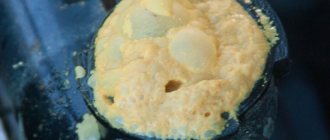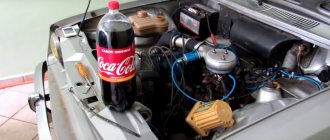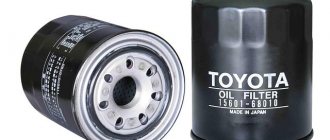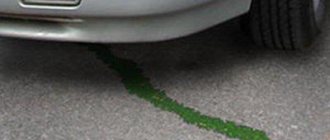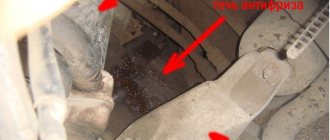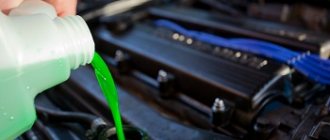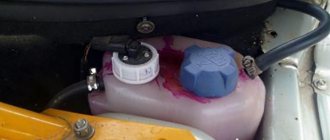Hello, dear friends! Today we will talk about if antifreeze is mixed with antifreeze, what will happen from such a combination, and what consequences this could potentially lead to.
We have already talked to you about mixing antifreeze by color and other parameters in this material, but there we were talking specifically about different antifreezes. Today we will compare concepts such as antifreeze and antifreeze.
They are not exactly the same thing, contrary to popular belief. Therefore, you will have to delve into the question and finally understand whether it is possible to connect them with each other, or whether this is a very bad idea.
Differences
However, apart from some subjective opinions from car owners, antifreeze itself and modern foreign antifreeze differ from each other in components and also in established performance characteristics during use.
Antifreeze is much more aggressive in its effect on the internal elements of the engine and on the pipes, as well as on the engine cooling systems, which is why antifreeze contains a special silicate, which, as the mixture is used, is deposited on the surface of the cooling system tubes and perfectly protects the engine from the effects of corrosion .
Antifreeze itself is much weaker in its effect on the car and for this reason it does not contain silicate. That is why mixing antifreeze with the same antifreeze or replacing antifreeze with antifreeze without first cleaning and washing the pipe system in the engine can provoke corrosion of internal elements and lead to the appearance of corrosion on the engine and other contaminants in the car’s cooling system. This can disrupt engine operation and completely damage the car within a short period of time.
It is also worth considering that different types of automotive antifreeze are based on different compositions - ethylene glycol or propylene glycol plus a list of third-party additives. In addition, you should not smell antifreeze, or even try to taste it - any antifreeze for the cooling system is poison.
Antifreezes are distinguished in such areas as performance lubricating and general anti-corrosion characteristics, including average aggressiveness towards many internal elements of the engine, such as engine seals and gaskets, as well as pipe systems for supplying the coolant mixture to the engine, also differ in freezing point and boiling point.
External (including color) differences between antifreezes are expressed in the thickness and actual shade of the mixture: on sale you can see red antifreezes, blue ones, which are rarer on the shelves, and also green ones. Antifreeze is given its tint by special additives - dyes.
The dyes themselves mean the possibility of mixing one type of antifreeze with each other from different manufacturers. It is worth considering that, for example, when mixing red antifreeze with the same red antifreeze, even from another manufacturer (although this should not be done in any case), the antifreeze will not begin to foam and sediment will not form in it.
But at the same time, based on existing reviews from car owners, most often you can not worry and calmly mix antifreezes of different shades (add one to another). In any case, no one can accurately predict the outcome of this operation.
It is important to consider: cars that came to us from Japan are usually filled with light red antifreeze, but this antifreeze is not designed for cold weather and cannot be poured in Russian frosts
You can, of course, drive with such antifreeze, but it is still advisable to change it as soon as possible. At the same time, what antifreeze should be purchased for replacement is a matter of your personal preference. Some try to purchase only imported antifreeze from well-known manufacturers, some prefer domestic products and do not want to overpay. Keep in mind that when purchasing antifreeze, you should pay attention to its shade (if you only want to mix and add another antifreeze to your car).
Types of antifreeze
There are three main types of antifreeze: G11, G12 and G13.
Liquids of the G11 group can no longer be found on sale so often. They are colored green or blue. G11 antifreeze contains both organic and chemical additives, including carboxylic acid. The latter effectively fights pockets of corrosion. However, such liquids form a very thick protective layer, which impairs thermal conductivity. In addition, G11 refrigerants do not have a long service life - their service life is no more than 60 thousand kilometers (like antifreeze).
G12 antifreeze is the most popular among car owners. They are usually colored red. Liquids of this group have good heat-conducting properties, do not boil at high temperatures, and do not form sediment. G12 refrigerants are excellent for copper and brass radiators, but are not recommended for use with aluminum ones.
It must be taken into account that Japanese G12 antifreezes have slightly different characteristics than European ones. In particular, they are not designed for use in harsh conditions; their crystallization temperature is -25 ° C.
The G13 group appeared relatively recently - in 2012. The main difference between antifreezes in this category is their composition. Instead of ethylene glycol, they contain propylene glycol, which has a less aggressive effect on the environment. G13 coolants are purple.
What happens if you mix antifreeze with antifreeze?
Firstly, the question is why mix these two different refrigerants. Well, various circumstances happen on the road, for example, there is an antifreeze leak and after eliminating the leak, you need to add antifreeze. But there is not always a canister of antifreeze in the trunk, and here they sell antifreeze nearby on the side of the road. You have to buy it and top it up to continue moving forward.
We recommend: Intercooler - what is it in a car
Or, as often happens, sooner or later after buying a used car, you have to top up the coolant, and then the driver asks the question: what was filled in before? Color is easy to determine, but classes are difficult. In such cases, experts recommend, again, not to save, but to drain the old fluid and fill in the new one in full. It is even possible that the old one has expired.
But, let's look at what happens after adding antifreeze to antifreeze.
From the composition we know that they only have in common water and, perhaps, a standard (ethyl alcohol). And each manufacturer adds different additives and additives in different quantities. Therefore, when mixing antifreeze and antifreeze, a sediment may form that will settle in the channels and on engine parts, which will gradually reduce the life of the internal combustion engine. Nothing bad will happen when adding antifreeze to antifreeze if their components are basically the same, but this cannot be checked with your own hands without a chemical laboratory.
Based on the above, we conclude that if you already had to mix antifreeze and antifreeze, then upon arrival, it is better to drain this liquid, do a complete flush of the engine cooling system and fill in a new homogeneous mixture. The cost of buying new antifreeze will save you a lot of money, effort and time.
In case of a hopeless situation
Let's look at the question of whether antifreeze and antifreeze can be mixed or not, in more detail, and determine how this happens:
Confusion about the color of the liquid. This point has already been mentioned in our article. No need to select coolant by color
. Manufacturers do this to differentiate their products.
A leak
. Different situations happen in life, and it may happen that you will not be able to find the exact brand of coolant that you had. Therefore, you will have to use what you have.
Some experts argue that mixing antifreeze from different manufacturers is quite possible, and that this will only benefit your car.
All of the above only leads to the right decision. Only a specialist who really knows in this matter will answer your question whether or not antifreeze can be mixed with antifreeze from various manufacturers. To our own - absolutely not, under no circumstances. This is because no one can predict how these two liquids will behave if you mix them.
And if you decide to mix them into one, then most likely a sediment will appear first. You may be able to observe foaming, which is not acceptable in the coolant mixture. Also, if suddenly these components do not match the composition, then it is likely that your cooling system will be completely clogged. Consequently, quite expensive repairs will be required.
What is the difference between Tosol and antifreeze?
To understand what consequences will arise when mixing these liquids in a car’s cooling system and whether this can be done, you need to understand the difference between these refrigerants.
Compound
Different brands of coolant may differ in composition and technical features. Antifreeze is any non-freezing refrigerant designed for use in an automobile cooling system. Antifreeze is considered one of the types of coolant. Previously, this liquid was the only one in the USSR.
According to the standard used at that time, this refrigerant could be of two types:
- -40. This product turned blue and froze at an air temperature of -40 degrees. The substance was used in most regions of Russia.
- -65. This refrigerant was colored red and was considered “arctic”. It was used in conditions of critically low temperatures and was developed for cars operating in the Far North.
If we talk about the composition, the base of both antifreeze and antifreeze is ethylene glycol. This substance is characterized by a low freezing point. When mixing ethylene glycol with distilled water in a 3:2 ratio, the liquid begins to crystallize at a temperature of -40 degrees. Up to this threshold, the viscosity of the coolant does not increase and the solution does not stratify. The product may be based on propylene glycol, glycerin or monohydric alcohols.
But ethylene glycol, which forms the basis of almost all modern refrigerants, has certain disadvantages:
- This substance is poisonous, so you must be careful when using it.
- It is characterized by increased corrosive activity towards metal alloys, copper and aluminum. If you pour pure concentrate into the cooling system, it may damage the radiator and power unit. The pump and thermostat are especially susceptible to negative effects.
The Avto-Blogger channel published a video that details the differences between refrigerants of different standards.
To prevent such problems, coolant manufacturers add a set of additives - corrosion inhibitors - to the refrigerants. They allow you to protect the power unit of the machine, while the service life of the product is limited. The spent substance is unable to withstand its own aggression towards steel. Depending on the manufacturer, different types of additives are used, which determines the compatibility of the products as well as their applicability.
In the case of Antifreeze, it is not corrosion inhibitors that are used, but silicate additives that reduce the formation of rust. This supplement option is cheaper and less effective. The service life of silicate additives is on average about two years, and the product begins to lose properties when heated to more than 108 degrees. Due to overheating of the internal combustion engine or the pouring of antifreeze into BMW N series engines, the operating temperature of which reaches more than 100 degrees, the liquid will quickly lose its properties and in fact become useless.
We recommend: Symptoms of a faulty coolant temperature sensor
The additives used in Antifreeze act on a different principle. The liquid forms a protective film on all surfaces of the cooling system where it circulates. This layer is inert and silicate. Its formation helps to reduce the level of heat transfer. As a result, the use of Antifreeze in highly accelerated units is not allowed. If the channels of the engine cooling system are too narrow, the flow area can be reduced to a minimum parameter. Because of this, it will be necessary not only to drain and replace the refrigerant, but also to flush the clogged channels.
Technical properties
Antifreeze and traditional antifreeze differ from each other in the following characteristics:
- boiling point;
- threshold for crystallization of a substance, that is, freezing;
- anti-corrosion features;
- lubricating properties.
The Pro Auto32 channel made a video that talks in detail about the main differences between Antifreeze and antifreeze.
All coolants are divided into organic, mineral or lobrid.
They differ in the set of additives they use:
- The service life of organic products is up to 5 years or 250 thousand km.
- Antifreeze is a type of mineral antifreeze. Its service life varies around 2 years or 50 thousand km.
- Lobrid refrigerants are allowed to be mixed with other types of liquids. The main feature is approval for use in almost any engine of new cars.
All coolants are divided into standards:
- G11;
- G12;
- G12+;
- G12++;
- G13.
What happens when mixed?
The use of Antifreeze is more relevant in Russian and Ukrainian-made cars. This is due to the aggressive composition of the fluid, which can have a destructive effect on the operation of the cooling systems of foreign cars. As for other refrigerants, their use is allowed in all brands of cars. It is not recommended to mix blue, red, green or yellow antifreeze. Typically, liquids of different colors have fundamental differences in composition.
What happens if you mix Antifreeze with antifreeze, which have a different base and additive package:
- Sediment and deposits will appear in the cooling system channels. Its pipes will be clogged, and when the engine temperature reaches a certain point, this will lead to foaming of the substance. Normal functioning of the cooling system will be impossible.
- The motor will not be able to cool properly. In his work there will be problems associated with a lack of heat exchange. The components of the power unit and radiator device may not withstand high loads.
- As a result of mixing different compositions, the mixture will begin to crystallize even during mild frosts and boil at average temperatures. The functioning of the power unit will be disrupted.
- Due to the chemical reaction, the additives present in the fluid will not be able to protect the system from rust formation. This will cause premature malfunctions and destruction of the metal components of the internal combustion engine and radiator.
An experiment on mixing refrigerants of different standards is described in a video filmed by the Avto-Blogger channel.
Why are these coolants mixed?
In the post-Soviet space, Tosol liquid was very common for engine cooling. Firstly, this antifreeze was almost the only one sold in auto stores, and secondly, domestic drivers at that time still trusted their manufacturer more than a foreign one. Therefore, in conversations with experienced motorists, refrigerants are still called “antifreeze.”
Refrigerants of different colors
Today you can find two types of coolant (coolant) on sale:
- salt-based refrigerant (can be blue or green);
- acid based refrigerant (red).
As for the composition, the basis of any coolant is ethylene or polypropylene glycol. Since ethylene antifreezes are more toxic, polypropylene glycol coolants have recently become increasingly popular.
Why interfere with the coolant? Each driver answers this question differently. For example, if there is a leak in the cooling system and the antifreeze is leaking, then the driver has to buy a different brand of coolant so as not to stall somewhere on the road. So, liter by liter another refrigerant is poured in and the compositions are mixed.
Some “garage specialists” advise car enthusiasts to mix the coolant so that there are more additives in the system. In their opinion, this will protect the system from the effects of corrosion and decay of particles in the consumable material, but this is far from the case. This is especially true in winter. In the summer, instead of coolant, you can even fill the system with water if there are no other options, but before the onset of cold weather it must be changed, otherwise:
- the water will freeze in any case at sub-zero ambient temperatures;
- if the frost is severe, the expansion tank will crack under the influence of ice;
- The cooling system pipes may also crack at the joints, and this will be very difficult to detect.
Refrigerant in the expansion tank of a car
Is it possible to do this and what will happen?
Is it possible to mix Tosol with antifreeze, and what will happen if you do this? This question has probably been asked by every vehicle owner. We will try to answer this question.
First, you need to understand that you should not navigate the coolant by color, as is customary among domestic motorists. They do not need to be divided into “Antifreezes”, red and green antifreezes. When mixing, their composition is important, and color plays a secondary role. We will talk about this further. When mixing coolant, it is important to familiarize yourself with the composition of the substance being poured and the consumable being poured.
Also, do not forget that any refrigerant is a mixture of a base (polypropylene glycol or ethylene glycol) with water, dyes and all kinds of additives.
Fill "Antifreeze" into the expansion tank of the car
Each auto manufacturer uses a specific package of additives, and even in the line of one manufacturer, refrigerants may differ in composition and amount of additives. They can be:
- anti-corrosion;
- anti-foam;
- additives to prevent the effect of antifreeze on the rubber elements of the cooling system.
We recommend: 5 steps to install air suspension yourself
And there are a lot of types of such additives. Therefore, when mixing coolant, it is necessary to take into account the characteristics of each car, as well as the composition of the liquid, so that you do not end up with a “mix” of additives.
If you are still asking the question “is it possible to mix Tosol and antifreeze?”, then we will answer unequivocally: in fact, there is nothing wrong with this if the coolants have the same composition.
For example, coolant from a domestic manufacturer is more aggressive towards the channels of the cooling system. Because of this, silicate is added to it, which settles on the walls of pipes and other elements and protects them from corrosion. Traditional antifreeze does not have such a destructive effect on the cooling system, so silicate is not added to it. But it contains other additives.
Spoiled brown refrigerant
If you mix antifreeze with Antifreeze or change one consumable element to another with a different composition, then it is better to do this with a complete flushing of the cooling system. Otherwise, the metal components of the system may corrode or sediment may form in the system, which will clog the channels and degrade the properties of the refrigerant as a whole. That is why mixing these two types of liquids with different compositions is best done as a last resort. It is quite possible to mix Antifreeze and antifreeze if these refrigerants have the same composition but different colors.
Now let's talk about color. The color of a substance means that it is possible to mix liquids of the same color, but from different manufacturers. For example, red refrigerants can be mixed with red antifreeze - in this case, it is guaranteed that the liquid will not foam in the system and will not form a sediment that will clog it.
Which refrigerants are not sensitive to mixing? These are liquids of the “G12”, “G12+” and “G11” standards. The colors of these coolants can be yellow, blue, red, green. “G12” consumables can be safely mixed with each other (meaning different industries) and with “G 11” liquids.
A little more about flowers
DIY car tinting at home: simple technology
Quite often you can see advice from motorists who mix liquids based on their color.
They are sure that when the coolant has the same color, then their composition is completely identical.
This is a categorically incorrect statement. Everything is extremely simple. Currently, there are no standards and requirements regulating the separation of coolant based on such characteristics as color. This allows you to color any antifreeze green, yellow, orange, or even purple or lilac. The only question here is the dye, and the desire to give your product a more attractive appearance.
Things are a little better with antifreeze. They are usually red, blue or light blue. Additionally, watch the video.
Coolant should be mixed according to characteristics, not color.
This is important to remember in order to avoid irreparable mistakes.
By the way, if you buy a car on the secondary market, the primary task will be to completely replace all working fluids. Even when the seller claims that the car is fully serviced, for your own peace of mind it is worth draining the engine oil, changing the lubricant in the gearbox, flushing the cooling system and choosing antifreeze or antifreeze that meets the requirements of the automaker.
Read more about coolant production in this material.
Have you ever mixed antifreeze and antifreeze? What principles were you guided by and what did it lead to?
Share stories from your life, give good advice to those who may make your mistakes.
Thanks everyone for your attention! Let's say goodbye.
How to replace?
- To replace the cooling mixture, take its concentrate and then add distilled water to it (you should purchase water at a car dealership). Most often, antifreeze is usually diluted in a ratio of 1 to 1, however, on the package with the concentrate itself there is usually a diagram for a better idea of what corresponds to what when mixed.
- It all depends on this diagram - from it you can find out whether it is possible to mix antifreeze and this particular antifreeze. However, if the schedule on the packaging does not contain the necessary information, I would not advise taking risks, since the likelihood of damaging the cooling system is quite high.
- Before purchasing, you should definitely see how well the new mixture combines with the old one. You can also mix a small volume of both, after which you can monitor whether sediment has appeared in the system pipes. And then, after draining the old mixture and thoroughly washing it, new antifreeze is actually added.
Coolant color
When choosing a specific type of coolant, many novice car enthusiasts focus only on the color of the liquid. This is a serious misconception. Indeed, at this time there are no strict standards for color compliance with chemical characteristics. Therefore, a situation may arise when a motorist buys a green coolant, but according to its characteristics this liquid does not fit the G11 marking.
Good to know: Reasons for oil getting into antifreeze
As for antifreeze, everything is much predictable here, and basically the color of the liquid corresponds to its chemical properties.
Differences between antifreeze and antifreeze.
Today, three types of coolants for internal combustion engines are used: water (distilled or pure rainwater), antifreeze and antifreeze.
Antifreeze is the name of the liquid (translated as “anti-freeze”) for the engine cooling system, which does not freeze and can withstand high temperatures.
Standard composition of antifreeze for cars:
- Water.
- Ethylene glycol.
- Glycerol.
- Alcohol.
- Acid salts or carbonate additives.
Composition of antifreeze:
- Water.
- Anti-corrosion additives.
- Burates and phosphates.
- Alcohols.
- Glycols.
- Nitrites.
- Silicates.
- Nitrates.
Differences:
- antifreeze was invented later than antifreeze;
- Antifreeze is better in terms of environmental friendliness;
- The boiling point of antifreeze is higher;
- The freezing point of antifreeze is lower;
- Antifreeze provides better protection against corrosion.
- Antifreeze forms a protective film, but antifreeze does not, and therefore antifreeze cools much more efficiently.
- The service life for which antifreeze is designed is 6 times less than that of antifreeze.
- antifreeze protects engine cylinder liners from cavitation (air bubbles).
- The service life of the pump (pump) is significantly reduced if antifreeze is used.
- antifreeze does not clog radiators, and various types of deposits do not form.
The main disadvantage of antifreeze is that when heated to 105 degrees, its properties deteriorate.
Antifreeze boils when heated to 115 degrees and does not leave sediment in the channels and can be used for up to 250,000 km.
Expert opinion
Car owners and specialists from various service stations argue that having the required amount of antifreeze and antifreeze on hand, there is no benefit or common sense in mixing these two substances. But during operation, there are situations when the first substance leaks on the road and to make up for this leak you have to use a second one, which happened to be at hand. This solution is the only correct one if the air temperature drops below 0 degrees.
But as soon as the motorist gets to the nearest service station, the following steps must be performed:
- purchase the required brand of antifreeze in the required volume;
- drain the mixture of two coolants;
- thoroughly clean all elements of the system;
- Fill the new coolant to the required level.
This is the only way to protect yourself from difficulties in the operation of the system and the car in the near future.
Coolant Concepts
As you know, the radiator cools the liquid, which is responsible for regulating the temperature of the engine. In fact, it is the coolant that prevents the engine from overheating.
When filling coolant, it is important not only to correctly calculate the proportions for the concentrate, but also to select the appropriate composition in accordance with the requirements of the car manufacturer.
Violations of the rules for filling and using coolant can lead to breakdown of the water pump, and also become one of the main reasons for engine overheating, which is important to remember.
First of all, let's figure out what antifreeze and antifreeze are, whether they can be the same color and how they differ from each other. This will greatly affect their compatibility.
- Antifreeze
. A product of Soviet developers who thus wanted to create an alternative to imported antifreeze. Originally it was red and blue. The first withstood cold down to -65 degrees Celsius, and the second up to -40. The composition is approximately the same. This is ethylene glycol combined with water and additives; - Antifreeze
. There are many varieties. But there are 3 main classes. These are G11, which is most often green, predominantly red G12, and yellow or purple G13. They differ in composition and application. The first two classes are based on ethylene glycol with water and additives. And the last type (G13) is based on propylene glycol. These are completely different alcohols.
Antifreeze class G13 can only be mixed with similar coolants.
But a natural question arises. If antifreeze and antifreeze of classes G11 and G12 are so similar, then they can certainly be mixed.
This is not entirely true. Here it is worth paying attention to additives.

